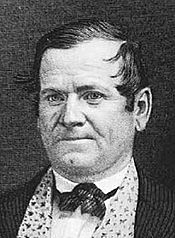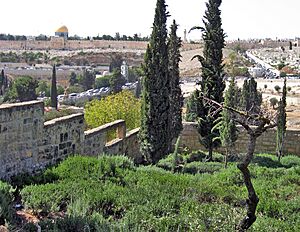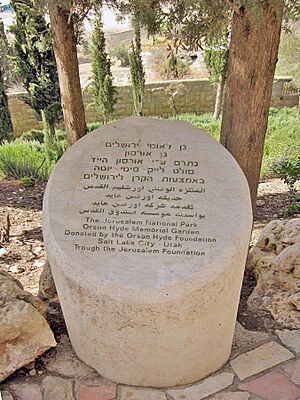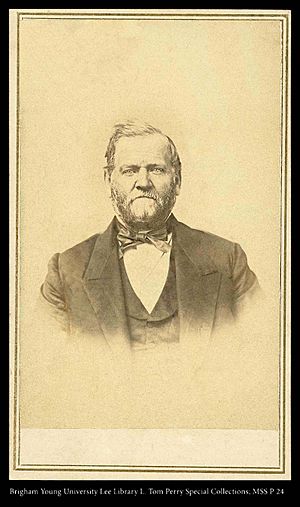Orson Hyde facts for kids
Quick facts for kids Orson Hyde |
|
|---|---|
 |
|
| President of the Quorum of the Twelve Apostles | |
| December 27, 1847 – April 10, 1875 | |
| Predecessor | Brigham Young |
| Successor | John Taylor |
| End reason | John Taylor replaced Hyde as President of the Quorum |
| Quorum of the Twelve Apostles | |
| June 27, 1839 – November 28, 1878 | |
| Quorum of the Twelve Apostles | |
| February 15, 1835 – May 4, 1839 | |
| Called by | Three Witnesses |
| End reason | Removed from Quorum by a vote of the church |
| LDS Church Apostle | |
| February 15, 1835 – November 28, 1878 | |
| Called by | Three Witnesses |
| Reason | Initial organization of Quorum of the Twelve |
| Reorganization at end of term |
Moses Thatcher ordained |
| Personal details | |
| Born | January 8, 1805 Oxford, Connecticut, United States |
| Died | November 28, 1878 (aged 73) Spring City, Utah Territory, United States |
Orson Hyde (born January 8, 1805 – died November 28, 1878) was an important leader in the early Latter Day Saint movement. He was one of the first members of the Quorum of the Twelve Apostles. From 1847 to 1875, he served as the President of the Quorum of the Twelve Apostles for the Church of Jesus Christ of Latter-day Saints (LDS Church). He also traveled as a missionary in the United States, Europe, and the Ottoman Empire.
Contents
Early Life and Beliefs
Orson Hyde was born on January 8, 1805, in Oxford, Connecticut. His mother passed away when he was seven years old. Because of this, Orson and his eleven brothers and sisters were raised by different foster families. He grew up in Derby, Connecticut, with a man named Nathan Wheeler.
When Orson was 14, he walked from Connecticut to Kirtland, Ohio, to live with Wheeler. He worked there as a store clerk. In 1827, Orson joined the Methodist church. Later, he became part of the Reformed Baptist Society, also known as the Campbellites, after hearing Sidney Rigdon preach. By 1830, he was a pastor for the Campbellites in Mentor, Ohio.
Joining the Church and Early Missions
In late 1830, Oliver Cowdery and other Latter Day Saint missionaries came to Kirtland. Orson Hyde first spoke against the Book of Mormon. However, when his former minister, Sidney Rigdon, joined the Latter Day Saint church, Orson decided to learn more. He was baptized by Rigdon in October 1831.
Soon after, he was ordained as an elder and then a high priest. Orson was called to serve many missions for the church. He traveled with other early leaders like Hyrum Smith and Samuel H. Smith. In 1832, he was one of the first missionaries in Connecticut. He also preached in Maine and Massachusetts. During one mission, he walked about 2,000 miles through several states. He often talked about his new faith with his old Campbellite friends.
In 1833, Orson Hyde was part of the first School of the Prophets. He also marched with Zion's Camp in 1834. On February 15, 1835, he became an apostle and one of the original members of the Quorum of the Twelve. He was the fifth in line of seniority. David Whitmer, Oliver Cowdery, and Martin Harris ordained him. After becoming an apostle, he served more missions in the United States and Canada.
In 1837, he went on a mission to Great Britain with Heber C. Kimball. They returned in 1838, having helped about 1,500 people join the church.
Challenges and Return to the Church
When Orson returned from Britain, the church was facing difficult times. There was persecution and disagreements among members. For a short time, Orson felt God was not with the church. He left the church on October 19, 1838.
However, Orson soon changed his mind. On June 27, 1839, he returned to the church in Nauvoo, Illinois. He publicly apologized for his actions and asked to be welcomed back. He was readmitted into the Quorum of the Twelve Apostles on the same day.
Mission to Jerusalem
In March 1840, Orson Hyde had a special vision. He felt that he should visit the cities of London, Amsterdam, Constantinople, and Jerusalem. In Jerusalem, he was to tell the Jewish people that they should "gather together" and "go into the defenced cities."
He began his journey and traveled through Germany, the Ottoman Empire, and Egypt. He spent some time in Bavaria to learn the German language. Orson arrived in Jerusalem in April 1841 and stayed until December 1842.
On October 24, 1841, Orson Hyde offered a special prayer in Jerusalem. He dedicated the land of Palestine for the return of the Jewish people. After this, he built a small altar with stones on the Mount of Olives.
Today, the Orson Hyde Memorial Garden stands on that spot. It was dedicated in 1979 and helps remember his important mission. After his mission, Orson traveled back through Europe. He stopped in Germany to create the first LDS Church pamphlets in German.
Family Life
Orson Hyde married Marinda Nancy Johnson in Kirtland, Ohio, on September 4, 1834. Later, as was practiced by some members of the church at the time, Orson Hyde entered into plural marriage. He eventually had eight wives and was the father of 32 children. He and Marinda divorced in 1870.
Later Life and Leadership
After the death of Joseph Smith in 1844, most Latter Day Saints moved from Nauvoo to Iowa Territory. Orson Hyde stayed behind to help finish the Nauvoo Temple, which was dedicated in 1846. He also served on the Nauvoo City Council and joined the Council of Fifty.
He then returned to England, where he led the British mission from 1846 to 1847. During this time, he also edited the Millennial Star, a church publication in England. When he came back to the United States, he became the President of the Quorum of the Twelve in 1847.
Orson Hyde was put in charge of the church in the Midwest and stayed in Council Bluffs, Iowa, until 1852. He published a newspaper called the Frontier Guardian there. In 1852, he moved to Utah Territory.
In Utah, Orson Hyde served as an associate judge for the U.S. Supreme Court starting in 1852. He also helped lead groups of church members to settle new areas, like Carson Valley, Nevada, and the Sanpete–Sevier District in Utah. He was a member of the Utah Territorial Assembly.
In 1875, there was a discussion about who should be the senior (oldest in service) member of the Quorum of the Twelve. Brigham Young decided that if a member had left the Quorum and then returned, their seniority would start from the date they rejoined. Because Orson Hyde had left and rejoined in 1839, his seniority was changed. As a result, John Taylor became the President of the Quorum of the Twelve Apostles in 1875.
Death and Legacy
Orson Hyde passed away in Spring City, Utah, on November 28, 1878, at the age of 72. He had suffered a severe stroke the day before. He is buried in Spring City.
Orson Hyde is mentioned by name in six sections of the Doctrine and Covenants, which are important scriptures for the church. Andrew Jenson, a church historian, described Orson Hyde as a very talented person who gained a good education and much experience from his travels. He said Orson was a "powerful instrument in the hands of God" for sharing the gospel and building up the church.
Images for kids
See also
 In Spanish: Orson Hyde para niños
In Spanish: Orson Hyde para niños








